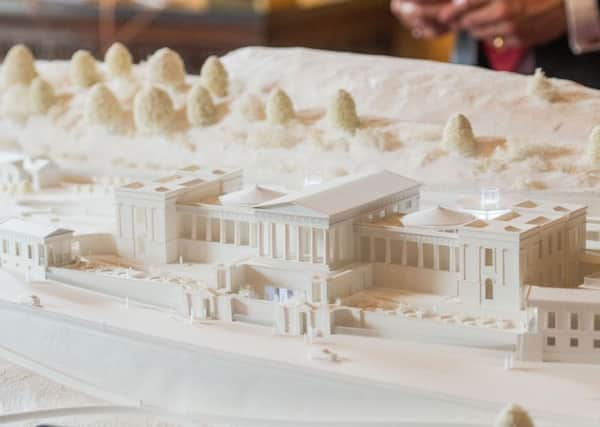2017 Arts Preview - The Year Ahead in Classical Music


Fast-forward 365 days, and I’ve just written my reflection on 2017, in which I congratulate Edinburgh on a seismic cultural hat trick. Two key classical music projects are now absolute goers, and the arts world has doffed its collective hat to the King of Festivals, the Edinburgh International Festival, which reached the grand old age of 70 in August and threw one helluva party.
Or maybe not. There is, of course, a bleaker alternative scenario. I could instead find myself writing that the plans revealed late in 2016 to give Edinburgh, its resident Scottish Chamber Orchestra and the EIF, among other potential users, the midsize concert hall it desperately needs are floundering in a sea of parochial bureaucracy, and opining that what seemed like a ray of hope at the start of the year was, in fact, just another puff of speculative wind.
Advertisement
Hide AdAdvertisement
Hide AdMeanwhile, up on Calton Hill, the power tactics of commercial developers Duddingston House Properties may have finally won over the council planners, quashing any hope that the iconic former Royal High School – a building originally conceived for the purpose of education – would find fresh life as the perfect new home for St Mary’s Music School.
As for the Festival, well, it’s hard to imagine a set of circumstances in which its 70th edition won’t be a success. Odds are it will go well, and its pervading themes (they won’t be too constraining or overt, says the EIF) will catch the spirit of its original 1947 post-Second World War aspiration to “provide a platform for the flowering of the human spirit”.
“There will be a bigger opera programme in 2017 than in recent years”, the Festival informs me, although we know nothing of its content yet. That information will emerge at the launch on 15 March, with tickets available ten days later. But it’s an area of Festival programming that has visibly eroded since Scottish Opera’s Ring Cycle 13 years ago, and which no amount of sleight of hand (concert performances of opera in the Usher Hall) can fully address. Let’s assume, then, that “more opera” for the EIF’s 70th birthday bash means more of the fully-staged variety.
As for the 2017 EIF Usher Hall orchestral programme, we can expect “references to the past”, through themes and specific pieces that have “resonance with the 70-year history of the Festival”. And will music have a part to play in EIF director Fergus Linehan’s third multi-media Festival-opener with video design company 59 Productions, with its expected birthday theme? For now, the details remain hush-hush.
But what about these two major infrastructure projects, one in its infancy, the other currently in a state of bureaucratic paralysis?
Edinburgh should be really excited about the prospect of the new 1,000-seater city centre concert venue, presumably with all the supporting break-out space and facilities expected of a modern-day arts centre.
The prime mover is the SCO, which has long outgrown its current makeshift home in the cramped ecclesiastical conversion that is the Queen’s Hall. Lovely as it is for intimate musical soirees, it’s well past time the SCO had a custom-built home it could call its own.
Advertisement
Hide AdAdvertisement
Hide AdThere’s significant money from the Dunard Fund to set this estimated £45 million project properly in motion, channeled through the newly formed performing arts charity IMPACT. It’s labelled a “proposal” at the moment, so the next stage is to turn these nascent plans to build behind the iconic RBS building in St Andrew Square into a reality.
We need to see some real flesh on the bones, and clarity as to who will be constituents of the intended multi-user partnership and how that will affect the eventual design, and most importantly the concert hall acoustics. An architects’ competition will be held early in the New Year, and the projected opening date is currently around 2021. That’s not far away in construction terms. Let 2017 be the year Edinburgh promises itself a flexible mid-size venue to rival Glasgow’s City Halls.
As for the protracted tussle over plans to turn Edinburgh’s old Royal High School into either a luxury hotel or a vital new home for St Mary’s Music School, things have reached a hiatus.
A year ago, it looked as though the balance was tipping St Mary’s way, but the brakes were applied recently when rival bidders Duddingston House Properties tabled revised plans, thereby effecting a sist while the city boffins look at the new proposal.
In so many ways, the St Mary’s plan makes the most sense, not least in maintaining the cherished ex-school building as a high-profile educational establishment. St Mary’s has to move, having outgrown its current facilities. It remains cautiously optimistic that the RHS plan may yet go its way, with £15 million of Dunard Fund money secured to bankroll the project. There is a Plan B should stalling tactics further delay a decision, or, heaven forfend, if the decision goes the wrong way. 2017 should settle that question.
Of course, there’s much else to occupy our thoughts over the next 12 months, from the RSNO’s 125th Birthday Tour of America to Scottish Opera’s new production of Debussy’s Pelleas et Melisande, both in March, to any of the fantastic festivals – St Magnus, East Neuk, Lammermuir and Cumnock Tryst– that fill the off-season calendar.
And here’s one further wish. SCO principal conductor Robin Ticciati has been plagued by back injury for almost a year now, leading to cancelled engagements with his band. It would be wonderful to see 2017 be the year of complete recovery for this fascinating young maestro. ■